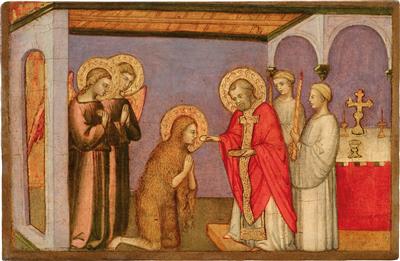Sienese School, late 14th Century

The Communion of the Magdalene,
tempera and gold on panel, 28.3 x 43 cm, framed
Provenance:
with Julius Böhler, Munich, circa 1930,
Private collection, Germany;
where acquired by the present owner
Possible Exhibition:
Cologne, Wallraf-Richartz Museum (according to a label on the reverse)
This scene represents an episode from the life of the Magdalene as told in the Golden Legend: after thirty years spent as a hermit in Provence, the saint was carried by angels to Saint Massiminio, the bishop of Aix, to receive communion during her final moments of life. In this scene she is received in the chapel that marks the place of her burial which was become the Basilica of Saint Maximin near Sainte Baume. Saint Mary Magdalene is shown accompanied by two Angels, she is represented kneeling and covered only by her long hair as she receives the host from Saint Massiminio, who in turn is assisted by two young ecclesiastics.
This panel is a fine, high quality, example of late Trecento Sienese painting revealing the predominant influence of Simone Martini. The bright colours and the linear contouring of the forms directly reflect the late gothic taste that asserted itself at Siena from about 1370 in the works of artists including Francesco di Vannuccio, Andrea di Bartolo and Paolo di Giovanni Fei.
Technical analysis:
The painting was accurately drawn before colouring. The underdrawing detected by IR reflectography is of three kinds: a linear thin black line, sometimes a little incised, to define accurately figures and folds, then followed in places by a brush or charcoal used to build the shape of the room, and finally a fine hatched drawing to give volume to the heads, in their shadows. In the back wall, a series of blind arches with small corbels was drawn but never painted, or rather covered with colour.
As reflectance spectrometry could ascertain, the violet hues of the architecture are obtained mixing natural ultramarine (from lapis lazuli stone) and a carmine type red lake (like kermes), the same lake employed in the pink of the angel’s clothes, while their shadows are made with a fine glazing of verdigris, to create an uncommon effect. Red lake and gold were used in the angel’s wings, while gold leaf is placed over a red bole preparation in the halos and all the gilded details. A silver leaf is used in the grey chalice on the altar. Verdigris is also employed in all the green colours of the architecture. All the red areas contain vermillion, glazed with red lake for the shadows.
We are grateful to Gianluca Poldi for the technical examination of the present painting.
24.04.2018 - 17:00
- Estimate:
-
EUR 40,000.- to EUR 60,000.-
Sienese School, late 14th Century
The Communion of the Magdalene,
tempera and gold on panel, 28.3 x 43 cm, framed
Provenance:
with Julius Böhler, Munich, circa 1930,
Private collection, Germany;
where acquired by the present owner
Possible Exhibition:
Cologne, Wallraf-Richartz Museum (according to a label on the reverse)
This scene represents an episode from the life of the Magdalene as told in the Golden Legend: after thirty years spent as a hermit in Provence, the saint was carried by angels to Saint Massiminio, the bishop of Aix, to receive communion during her final moments of life. In this scene she is received in the chapel that marks the place of her burial which was become the Basilica of Saint Maximin near Sainte Baume. Saint Mary Magdalene is shown accompanied by two Angels, she is represented kneeling and covered only by her long hair as she receives the host from Saint Massiminio, who in turn is assisted by two young ecclesiastics.
This panel is a fine, high quality, example of late Trecento Sienese painting revealing the predominant influence of Simone Martini. The bright colours and the linear contouring of the forms directly reflect the late gothic taste that asserted itself at Siena from about 1370 in the works of artists including Francesco di Vannuccio, Andrea di Bartolo and Paolo di Giovanni Fei.
Technical analysis:
The painting was accurately drawn before colouring. The underdrawing detected by IR reflectography is of three kinds: a linear thin black line, sometimes a little incised, to define accurately figures and folds, then followed in places by a brush or charcoal used to build the shape of the room, and finally a fine hatched drawing to give volume to the heads, in their shadows. In the back wall, a series of blind arches with small corbels was drawn but never painted, or rather covered with colour.
As reflectance spectrometry could ascertain, the violet hues of the architecture are obtained mixing natural ultramarine (from lapis lazuli stone) and a carmine type red lake (like kermes), the same lake employed in the pink of the angel’s clothes, while their shadows are made with a fine glazing of verdigris, to create an uncommon effect. Red lake and gold were used in the angel’s wings, while gold leaf is placed over a red bole preparation in the halos and all the gilded details. A silver leaf is used in the grey chalice on the altar. Verdigris is also employed in all the green colours of the architecture. All the red areas contain vermillion, glazed with red lake for the shadows.
We are grateful to Gianluca Poldi for the technical examination of the present painting.
|
Buyers hotline
Mon.-Fri.: 10.00am - 5.00pm
old.masters@dorotheum.at +43 1 515 60 403 |
| Auction: | Old Master Paintings |
| Auction type: | Saleroom auction |
| Date: | 24.04.2018 - 17:00 |
| Location: | Vienna | Palais Dorotheum |
| Exhibition: | 14.04. - 24.04.2018 |
